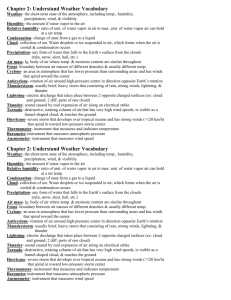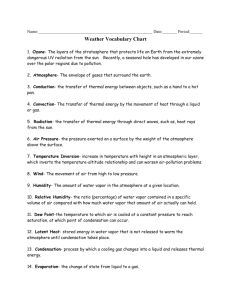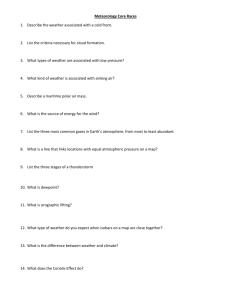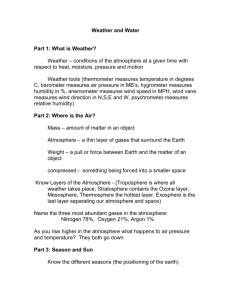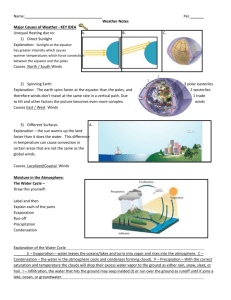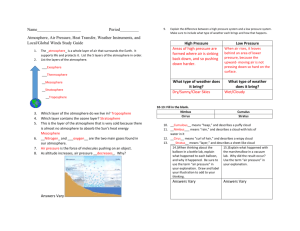Chapter7 Notes Teacher copy
advertisement
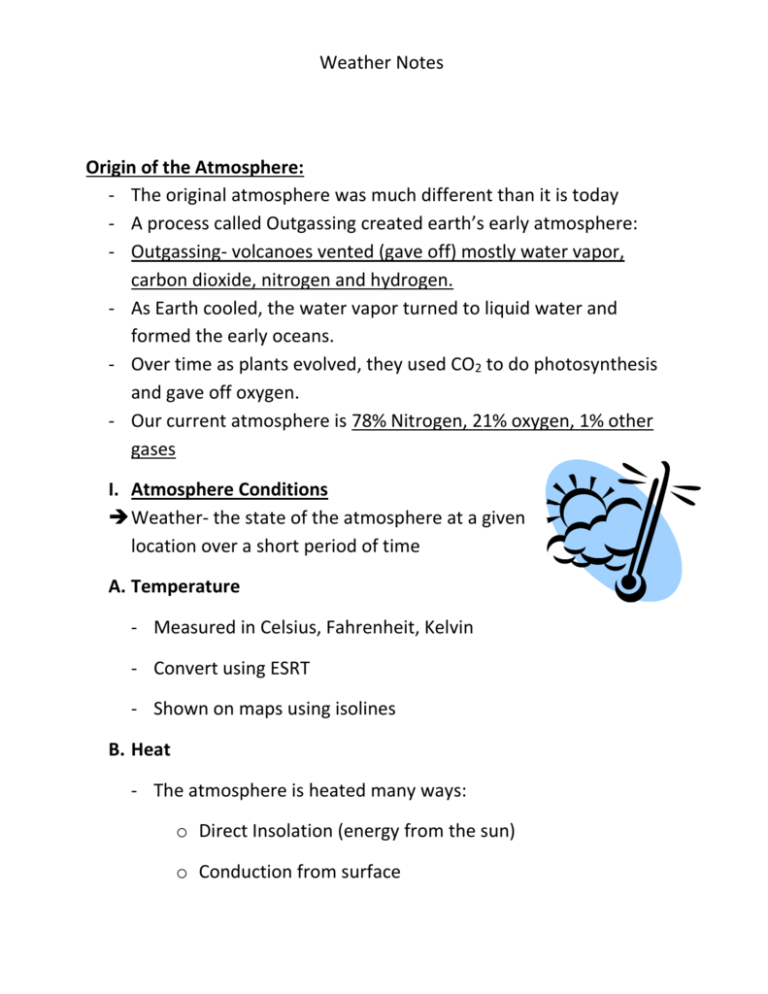
Weather Notes Origin of the Atmosphere: - The original atmosphere was much different than it is today - A process called Outgassing created earth’s early atmosphere: - Outgassing- volcanoes vented (gave off) mostly water vapor, carbon dioxide, nitrogen and hydrogen. - As Earth cooled, the water vapor turned to liquid water and formed the early oceans. - Over time as plants evolved, they used CO2 to do photosynthesis and gave off oxygen. - Our current atmosphere is 78% Nitrogen, 21% oxygen, 1% other gases I. Atmosphere Conditions Weather- the state of the atmosphere at a given location over a short period of time A. Temperature - Measured in Celsius, Fahrenheit, Kelvin - Convert using ESRT - Shown on maps using isolines B. Heat - The atmosphere is heated many ways: o Direct Insolation (energy from the sun) o Conduction from surface Weather Notes o Re-radiation from surface o Condensation from formation of fog, dew, clouds, frost o Friction between surface and atmosphere due to Coriolis effect. - Heat is transferred throughout the atmosphere by convection When a gas expands, temp. decreases o As air rises/expands, temp. goes down. When a gas contracts, temp. increases o As air descends/contracts, temp goes up C. Air Pressure & Density - Are directly related - Air Pressure- the pressure due to weight of overlying atmosphere pushing down on any given area - Barometer measures A.P. - Standard A.P.= o 14.7 lbs/sq.in. o 29.92 in. of Hg (inches of Mercury) o 1013.2 mb - Shown using isobars on weather maps Weather Notes D. Temperature & Air Pressure - As temp. increases, Density & Air pressure decrease E. Water vapor & Air Pressure (A.P) - As amount of Water vapor increases, Density & A.P decrease *Why? Because dry air is HEAVIER than moist air! Nitrogen’s molecular weight is 28 amu while a water vapor molecule is only 18!! - High pressure systems are often associated with clear skies & low/no precip. - Low pressure systems are often associated with cloudy skies & precip. F. Altitude & Air Pressure - As altitude increases, pressure and density decrease Weather Notes II. Winds - Caused by differences in Air pressure o Differences in A.P are caused by changing temp. and water vapor content. A. Air Pressure Gradient - The difference in Air pressure over a specific distance. - Shown by isobars o The closer together the isobars, the steeper (greater) the gradient - A large gradient (change in air pressure) means: HIGH WINDS!! **Look for isobars close together and you’ll find an area with high winds! B. Land & Sea Breezes (AKA. Local Winds) First, understand SPECIFIC HEATSpecific heat- the amount of energy needed to raise a material 1 C. Water has a very high specific heat so it takes longer to heat and cool off. Land surfaces (like sand on a beach) have a low specific heat so it heats and cools very quickly. Sea Breeze- Weather Notes - Land heats faster than water during the day - Air above the land heats faster and becomes less dense (lower air pressure) causing it to rise. - Cooler, more dense air from above the sea flows into land replacing risen air - Land Breeze- Warmer air forms over water during the night - The warmer air over the water becomes less dense (lower air pressure) and rises - Cooler air from land flows out to sea replacing the risen air C. Direction of Winds - Air (winds) moves from areas of high to low pressure - Higher pressure gradient creates higher wind speeds! - High Pressure areas produce winds that blow outward from the center and turn clockwise (Anti-cyclones) - Low Pressure areas produce winds that blow inward towards the center and turn counter clockwise (cyclones) - A wind is named for the direction it comes from o Ex. Wind blowing towards the North is a South Win Weather Notes III. Circulation of Air in the Troposphere A. Convection Cells - Unequal insolation on earth = unequal heating of surface = differences in air pressure - Results in series of convection cells at various latitudes - See ESRT, pg.14 - Areas of convergence- where air from convection currents come together (low pressure) - Areas of divergence- where air from convection currents come apart (high pressure) B. Jet Streams - Fast moving winds, 200mph or more - Move at top of troposphere, flowing easterly - Drive formation of weather & movement of weather C. Planetary Wind Belts - AKA. Prevailing Winds - Shift seasonally due to changing angle of insolation which results in changing pressure gradients - Cause seasonal weather changes (Ex. Monsoons) Weather Notes - US Prevailing winds = Southwesterly o Move SW to NE D. Ocean Currents - Caused by prevailing winds - NRG transferred to water - Can also shift position N or S reflecting seasonal changes in prevailing winds Weather Notes IV. Atmospheric Moisture - Moisture enters atmosphere by o Transpiration- water vapor released by plants o Evaporation A. How to increase the rate of Evaporation 1. Higher temp 2. More Surface area 3. Less moisture in air 4. More air movement B. Humidity - Absolute Humidity- amount of water vapor in the air - Relative humidity- ratio of how much water vapor air has and how much it can hold - RH & Temp o If temp increases, RH decreases - Dew Point- temperature at which air is saturated with water vapor o Below this temp. water vapor will condense Weather Notes C. Cloud Formation - When temperature in atmosphere drops below dew point. - A cloud is a collection of water (can be liquid or crystal form) - Cloud Cover- fraction/percent of total sky covered by clouds - Low Clouds/On surface= FOG - Needs condensation surface- a place for water to condense o Dew- condenses on grass/leaves o Clouds/Fog- condense on aerosols in air (volcanic ash, dust, pollutants) - Both air temp & Dew point DECREASE with increase in ALTITUDE- The altitude where temp & dew point are the same is the level where clouds form by condensation. o CLOUD BASE ALTITUDE D. Precipitation - Ice crystals or water droplets must come together in clouds to become big enough so they will fall due to gravity Formation of: 1. Rain- Temp. in cloud above 32° F, liquid droplets (.2mm diameter) Weather Notes 2. Drizzle- Temp. in cloud above 32 °F, liquid droplets (.2-.5 mm diameter) 3. Snow- Temp. in cloud below 32 °F, ice crystals 4. Sleet- Temp. in cloud above 32° F, liquid droplets freezes because air closer to ground is below 32° F 5. Freezing Rain- Cloud of liquid droplets above 32° F, freezes in contact with feature of earth’s surface. 6. Hail- forms in thunderstorm clouds, layers of ice/snow/liquid water E. Atmospheric Transparency & Precipitation - Effected by the amount of pollution o More pollution = less transparency / Less pollution = more transparency - PRECIPTATION will INCREASE atmospheric transparency! (i.e it makes it cleaner and clearer!)

